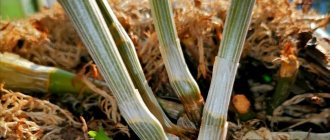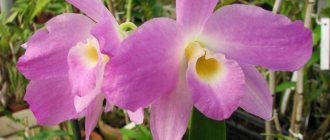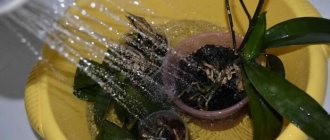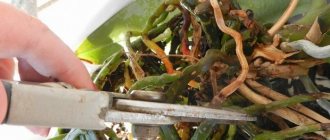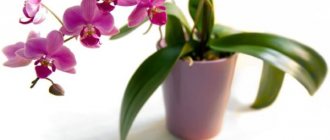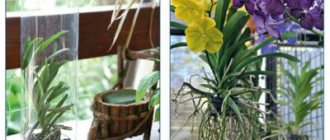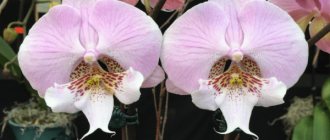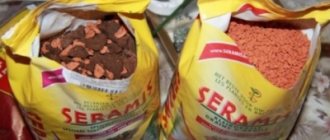Dendrobium Nobile is one of the most beautiful types of orchids, which is the most commonly grown hybrid at home. The natural habitat is the tropical mountain forests of South and Southeast Asia. The plant is valued for its presentable appearance, abundant flowering, and exquisite slightly sweet floral aroma.
Types and varieties of orchids
Among the varieties grown today, the most common subspecies are:
| Subspecies | Peculiarities |
| Dendrobium aphyllum | It is distinguished by a reddish tint of foliage and pseudobulbs. Loves bright sunlight and tolerates exposure to direct sunlight. |
| Dendrobium bellatulum | During the flowering period, the miniature epiphyte is covered with waxy white flowers with a red-orange or yellow throat. Has a light pleasant floral aroma. |
| Dendrobium christyanum | The miniature epiphyte Christie has white or cream-colored flowers with characteristic veins. The difference is the violin-shaped throat with a red-orange or yellow central part. |
| Dendrobium densiflorum | An exotic from the Eastern Himalayas during the flowering period is covered with clusters of fragrant flowers with bright yellow petals and a yellow-orange fringed throat. |
| Stardust | A specimen with a thin elongated pseudobulb up to 20 mm wide and red-orange or pale yellow flowers about 6 cm in diameter. |
| Phalaenopsis | The variety blooms 2-3 times a year, for 2-3 months. The color of the peduncles varies from white to dark purple. |
| Parisha | The miniature epiphyte has aerial roots and small flowers up to 2 cm in diameter. The color is milky white, with a purple throat. It blooms profusely and exudes a pleasant aroma. |
| Irene smile | The buds are scattered along the entire length of the trunk at a distance of 2-5 cm. The flowers are white-lilac in color with a yellow core. The epiphyte blooms twice a year, flowering duration is 4 weeks. |
| Unit | The epiphyte has a pseudobulb with a yellow color and multiple furrows. Clusters of inflorescences consist of 12-15 flowers with an amazing aroma, reminiscent of the sweetness of honey or molasses. |
| Akatsuki | Subspecies with dark green lanceolate leaves. The flowers are medium-sized, softly lilac in color, with a yellow core and a white (less often blue) edge. The diameter of the largest bud is 40 mm. It exudes a light floral aroma, more intense during the day and barely noticeable in the evening. |
| Apollo | A hybrid with a fleshy stem and dense leaves of a rich green color. It blooms 12 weeks a year, the flowers are white with a yellow throat, several are located on one peduncle. |
| King | In nature it is found on steep cliffs. It is distinguished by the presence of white scales on the stem, long lanceolate leaves, and medium-sized white flowers with a pink or lilac tint. |
Fertilizers to stimulate flowering
To achieve flowering from Dendrobium, you should add special fertilizers.
- Boric acid solution - used for leaf spraying, can be combined with phosphorus fertilizing. To prepare the solution, boric acid powder is poured with hot water at the rate of 1 g of powder per 1 liter of water. Spraying is carried out after the acid has completely dissolved and the water has cooled. The frequency of treatment with the composition is no more than 2 times a month.
- Nicotinic acid - can be used for spraying or for watering at the root. For feeding, nicotinic acid is used in ampoules in a 1:1 ratio - 1 ampoule contains 1 liter of water.
Self-prepared fertilizers are applied during the growth period of flowering shoots. When spraying, flower buds and peduncles are treated. When buds begin to form, stop feeding the flower.
Growing
Growing specimens of the Nobile variety is a difficult and responsible process, since the conditions in the house are very different from natural ones. And, as you know, the natural habitat of epiphytes is the tropical zone, the climate of which is extremely difficult to replicate in an apartment or house, but still possible.
Pot for Dendrobium
For exotics, the condition of the root system is extremely important. Therefore, special attention must be paid to the container that will serve as its “home.”
Since Nobile roots do not participate in photosynthesis, they do not require good lighting. Therefore, the main criterion when choosing a flowerpot should not be transparency, but the porous structure and breathability. A ceramic pot has these properties. A clay product “breathes” well and maintains optimal temperature and humidity levels. The bottom must have a drainage outlet. It is optimal if small holes are also located on the walls.
The size of the new container is equally important. Dendrobium Noble prefers cramped pots, so the distance between the roots and the walls of the flowerpot should not exceed 1.5-2 cm. You should not buy a ceramic pot with a “spare” - in a spacious container there is a risk of soil acidification.
Before planting, the pot must be properly prepared:
- treat with any disinfectant;
- bake in the oven at 200°C for at least 2 hours;
- cool and then place in clean water for a day so that the pot is saturated with moisture.
Soil for Dendrobium
Soil mixtures intended for growing ordinary indoor crops are very different from the substrate for orchids. Since the roots absorb a lot of air, you should choose light, loose soil. You can purchase a special soil mixture at a flower shop or prepare it yourself.
Optimal substrate composition:
- Pine tree bark. It is pre-boiled and dried to remove fungus and other infections.
- Sphagnum moss. It helps retain moisture within the soil.
- Charcoal. Divided into small pieces, it protects the substrate from souring during frequent watering.
- Crushed fern root. Suitable for loosening soil. As an alternative, coconut fiber, crushed wine cork, and pieces of polystyrene foam are used.
Expanded clay, river pebbles, crushed stone, and large fragments of tree bark are used to create a drainage base. To enrich the soil, it is useful to add a small amount of peat.
Humidity
Being an exotic, the representative of the Nobile variety grows better and fully develops at normal and high ambient humidity. In the summer heat, as well as in winter during the heating season, the bush slows down and sometimes stops its growth. Therefore, it is important to maintain air humidity at 40-60%.
You can increase the moisture level in this way:
- spray the ground parts with a spray bottle;
- wipe the leaf plates with a damp cloth at least 3-4 times a day;
- place the pot with the plant on a tray with moistened moss, expanded clay, and pebbles;
- purchase an automatic humidifier.
Temperature
In order for Nobile to develop normally and bloom, it is necessary to maintain not only suitable humidity, but also air temperature. Optimal daily indicators:
- in summer – 22-28°C;
- in winter – 15-20°C;
- in autumn and spring – 16-22°C.
However, with comfortable air humidity, exotic feels great even at 30-32°C.
An important stage of the annual cycle is the formation of buds. At this stage, it is important to maintain the temperature: 24-25°C during the day, 18-20°C at night. To stimulate the abundant appearance of flowers, it is necessary to ensure a difference in daily values of 5-10°C. To lengthen the budding process, the temperature must be lowered to 18°C. For normal development and timely flowering of an exotic crop, it is necessary to maintain a suitable temperature at home.
Optimal daily indicators:
- in summer – 22-28°C;
- in winter – 15-20°C;
- in autumn and spring – 16-22°C.
However, with comfortable air humidity, exotic feels great even at 30-32°C.
An important stage of flowering is the formation of buds. During this period, the temperature should be maintained: 24-25°C during the day, 18-20°C at night. To stimulate the formation of flower stalks, it is necessary to ensure a daily temperature difference of 5-10°C.
Features of care depending on the type of dendrobium
Dendrobium has many types. Their representatives can be divided into several groups. The separation criteria are the temperature requirements of the species and the need for watering.
- The first group includes varieties that develop comfortably at a temperature of 20-22°C during the growing season and at 12-15°C when the shoots have matured. During the growth period, the temperature at night is maintained at 12-15°C, the plants are fertilized and watered abundantly.
In autumn they are kept in cool conditions, reducing the night temperature to 10°C. Before flower buds begin to form, watering is reduced and fertilizing is stopped.
This process is cyclical and allows the plant to enter the dormant stage. If the process was disrupted, then vegetative growths - babies - form in place of flower buds. When the baby grows its own roots about 5 cm long, it can be transplanted into a separate container.
In such conditions, Dendrobium Nobile, or Noble, Chrysantum is grown.
- Species of the second group are kept in similar conditions: temperature during the growing season is 20-22°C, during the dormant period - 12-15°C. The difference lies in the night temperature - for varieties of this group it should be 12-15 ° C throughout the year. In autumn, watering is also reduced to a minimum and fertilizers are stopped.
This group includes representatives of Dendrobium such as Dendrobium findlayanum, Anosmus, Pierardia.
Advice! If Dendrobium Finlayanum does not bloom for a long time, you should lower the temperature during the next dormant period. It should be close to 12°C.
- Temperature indicators for growing plants of this group do not differ from those of the previous one. After the end of flowering, the orchids are placed in a cold place, and in the fall the temperature is reduced to 10°C. At the same time, watering is not reduced. When the substrate dries out, it is moistened again. In cold conditions, the flowers are kept until new growth begins. After this, they are returned to their usual conditions of detention.
These requirements must be met when growing Dendrobium Aggregatum, Farmer, and Dustflower.
- For varieties belonging to the fourth group, they can withstand daytime temperatures of about 20°C. Summer night temperature should be at 15°C, winter night temperature – about 12°C, but not more than 15°C.
As in previous cases, orchids are watered abundantly during growth and reduce watering after flowering. Plants do not require dry maintenance after growth is completed.
Varieties that need to create similar conditions for flowering: Dendrobium Lyon, Sander, Schultz.
- Species of this group are cultivated without a dormant period. Temperature indicators during their cultivation during their life cycle do not change. Night temperature is maintained at 15°C, daytime temperature is about 20°C. Plants are demanding of light and need fresh air.
If the flower is weak (with small leaves, short thin peduncles), then in winter you should prepare a short resting phase for it. To achieve this, the temperature does not decrease, but watering becomes less frequent.
Such content is suitable for Dendrobium Taurinum, Veratrifolium.
- The last group consists of species that require night temperatures ranging from 15 to 18°C. The watering regime varies depending on the variety.
Dendrobium Phalaenopsis and Superbens are watered as usual (when the substrate is dry) during flowering and during the growing season. Humidification is reduced after growth is completed until flowering shoots begin to form and after flowering ends until the next active growth. When watering is reduced, it is necessary to spray the flowers with a spray bottle between waterings to prevent them from drying out.
Baggaum does not need to reduce watering. However, it can be reduced if the plant does not bloom or is weakened.
If you do not know what variety of dendrobium you purchased, you should experiment with the temperature and monitor the condition of the flower.
Caring for a Dendrobium orchid at home
Dendrobium noble is very unpretentious in care and maintenance, but has a pronounced cyclical development. This means that it annually experiences 4 seasonal stages:
- active vegetation;
- budding period;
- bloom;
- rest phase.
If suitable conditions are created for each time period, this will ensure proper care.
How to water
Watering is an important part of comprehensive care for Dendrobium Nobile. An indicator of the presence or absence of moisture inside the substrate is the condition of the roots. The signal for watering is considered to be:
- change in root color from green to light gray;
- the substrate dries so much that the pot becomes light;
- decreased leaf elasticity.
The frequency and frequency of watering depends on the conditions of detention and the stage of development. The plant should be watered after the soil has completely dried. Boiled or filtered water slightly above room temperature is suitable for moistening the soil.
The regularity of watering also depends on the time of year:
- in summer - every 2-3 days;
- in autumn and winter - no more than 2-3 times a month.
After the flowering period ends with the onset of the resting phase, watering should be reduced to once every two weeks, while maintaining the frequency of spraying.
The epiphyte should be watered by immersing the flowerpot in a basin of warm water for 10-15 minutes. To remove excess moisture, you need to twist the pot, tilting it in different directions. During the procedure, you should avoid getting water inside the rosettes and bulbs to protect the bush from rotting.
Fertilizers
In addition to watering, it is important to feed Dendrobium in a timely manner, since its roots cannot receive the nutrients necessary for healthy growth from poor soil composition. Complex mineral fertilizers, which are used in the form of liquid solutions, are suitable for this purpose.
Depending on their composition, they are divided into two groups:
- Nitrogen-containing complexes. Used during active development to increase green mass.
- Potassium-phosphorus preparations. They are used at the stage of bud formation.
Liquid mineral compositions are applied every two waterings. If the immersion method is used, the dosage is reduced to half that recommended by the manufacturer. When foliar feeding for spraying leaves, the dose is reduced to 5 times. To prolong the budding period, fertilizing with mineral compounds should be limited as much as possible, and with the onset of the resting phase should be completely stopped.
Cutting
After Dendrobium Noble has bloomed, it is recommended to prune it. This is not done immediately, but after the old yellowed pseudobulbs have completely dried out. Until this moment, they are a source of food for young shoots. The cut areas should be slightly dried and then sprinkled with powdered charcoal.
Wintering
After the flowering phase, the bush goes into a dormant state. In order for him to have time to rest, it is necessary to change the tactics of care:
- Move the flowerpot to a cool place, maintaining the air temperature there: during the day - within 16-20°C, at night - 10-12°C.
- If the air temperature outside at night does not drop below +10°C, the plant can overwinter on a loggia or glazed balcony.
- Watering should also be gradually reduced, initially to 2 times a month, then to 1, and then stopped completely. The same applies to feeding.
If the pseudobulbs take on a wrinkled appearance, you need to spray the leaves and substrate with water from a spray bottle. In the last month of winter, you need to closely monitor the plant so as not to miss the moment when it begins to awaken.
Subtleties of watering during intensive growth
As soon as the orchid's buds swell, this means that the active growing season has begun. It is at this time that dendrobium is watered most often. For each variety, this period depends on the flowering period. For most of them it occurs in the spring. After the buds wither, a time of rest begins, and after it a new round of growth begins. At this time, the growth of green mass and the formation of flower buds occurs. The process lasts approximately 3 months, that is, all summer. This is the period when the plant needs a lot of moisture and nutrients.
The frequency of watering directly depends on the temperature. In summer, it is important to provide orchids with :
| During the day | +180 – +250 |
| At night | +140 – +200 |
Under such conditions, watering is carried out almost daily.
To moisten the substrate, use purified, non-hard water . It should be warm within 220 - 240.
Tip #1 . Note! For root irrigation, the optimal water temperature is 2-3 degrees higher than the surrounding air.
When watering, adhere to the following recommendations:
- For root irrigation , use a watering can with a long narrow spout. Direct the stream along the inner wall of the pot so that the water wets only the root system and does not fall on the leaves and pseudobulbs. If moisture accumulates in the mouths, rotting and disease of the plant may occur.
2. When watering, do not pour water into the mouths of the leaves, otherwise they will rot and become susceptible to fungal diseases.
- You need to ensure that the substrate is moist, but not wet . Excess water causes roots to rot. A repeat irrigation session is carried out when the soil mixture dries slightly in the top layer.
- Water so that water comes out in the pan. Then the excess must be drained.
- In summer, once every 10–14 days, the dendrobium is bathed . To do this, immerse the pot with the plant in a container with warm water +300 - 350. Leave for 5 - 10 minutes. This way the substrate is wetted evenly. Then, under a light shower, the ground part of the orchid is washed, this is called sprinkling. This not only washes away dust from the leaves, but also moistens the plates, which activates aeration and moisture exchange.
3. In summer, during intensive growth, the best method of watering is bathing combined with sprinkling.
- The best time for regular watering is morning. During the night, the temperature of the substrate and air are balanced, which reduces the difference between water and the environment.
Dendrobium bloom
In different regions and for each grower, the exotic Nobile crop begins to bloom at different times. This is due to the varietal characteristics of the hybrids, as well as their growing conditions.
Traditionally, representatives of the Nobile variety begin to bloom in early spring (from about the end of February to May). With proper care, exotic flowers continue to bloom for 3-4 months. And this happens every year. However, it happens that the bush misses the flowering season and produces buds only the next year, but lays more buds. With proper feeding you can achieve abundant flowering. To enjoy the delicate beauty and delicate aroma longer, the flowerpot with the epiphyte should be moved to a dry, cool place protected from sunlight.
In some exotic species, the period of budding and flowering ends with yellowing and falling of the once green foliage. This is how the plant prepares to move to a new stage - the dormant period. Reutilization of useful substances occurs: dying terrestrial parts become a source of nutrition for new growing pseudobulbs. For this reason, the peduncle with pseudobulb is not cut off, but is allowed to dry out on its own. If it continues to remain fresh, this means that the plant is preparing for the appearance of new babies. During this period, it is important to adjust the care of the epiphyte and ensure subsequent lush, long-lasting and abundant flowering.
Watering during dormancy
For many dendrobiums, the time of rest comes soon after the active growth of green mass and the formation of peduncles. Most often this occurs in the autumn-winter seasons . After an orchid has worked hard for 3-4 months, it needs to rest. This means that at first all vegetative processes slow down, and the “biological program” switches to the accumulation of nutrients for the upcoming flowering. Gradually, when the ground tissues store up a sufficient amount of energy, it freezes, as if hibernating. During this period, watering is canceled altogether. This phenomenon can be compared to the suspended animation of trees in winter.
In this state, the dendrobium survives the short daylight hours and the winter drop in temperature. At this time, the color of the roots should be green, and only the tips are covered with a silvery coating.
At this time, root watering is minimally needed; the plant has stored a sufficient amount of moisture in its cells. To wet the substrate, irrigation once a month is sufficient.
If the air humidity drops below fifty percent from heating devices, spraying is necessary.
- Spraying water is carried out not only on the leaves of the orchid, but around it. To do this, use a sprayer with a fine nozzle that creates a water mist.
- Another, less troublesome way is to place a shallow and wide bowl of water next to the dendrobium. So the moisture evaporates quickly and on its own. As the level decreases, water is added.
Transfer
The main difference between Noble orchids and ordinary indoor plants is their painful sensitivity to replanting. The epiphyte experiences stress and takes a long time to get used to its new “place of residence”, so it should be disturbed no more than once every 3 years. After purchasing, you should analyze the well-being of the orchid. If it is assessed as satisfactory, it is advisable to postpone the transplantation process until the next season.
However, there are situations when it is better not to hesitate:
- Unsuitable condition of the soil mixture. Over time, the substrate acquires excessive density and, when dried, breaks down into fine-grained fractions. It does not allow air to pass through well, does not accumulate nutrients, and becomes salty with compounds contained in the water.
- The capacity has visually become small. Due to excessive growth, the roots become cramped in the old flowerpot. Due to lack of lighting and aeration, they lose the ability to grow and develop normally.
- Damage by disease or pests. This is evidenced by the appearance of brown spots on the roots, yellow or black spots on the leaves. The latter become sluggish and lose elasticity.
It is recommended to carry out a planned transplant of the Nobile orchid in the spring, after the end of the flowering phase. For this purpose, the transshipment method is used.
Instructions:
- Water the orchid to make it easier to remove from the old pot;
- prepare a new flowerpot as described in the previous instructions;
- lay drainage at the bottom, and on top of it a 2-3 cm layer of soil;
- carefully, so as not to damage the earthen lump, remove the bush from the old pot;
- place in an empty flowerpot;
- holding the stems at the base with your left hand, quickly fill the voids with fresh substrate with your right hand;
- install a support to which to tie the plant;
- transfer to a cool (+20°C) shaded place.
If some of the roots are affected by rot, you will need to remove the affected parts with a sterile knife and treat the sections with charcoal. Place the orchid in a dry basin and leave for some time. When the roots dry out and the cuts become tight, transfer the orchid to a new pot, as described above.
The first full watering after transplantation is recommended after 7-10 days. By this time, the plant will have time to adapt to its new place of residence. Before this, only light irrigation on the leaves is allowed.
Planting and transplanting
For a Dendrobium orchid, replanting is an extremely painful procedure. Because of this, you need to do this as little as possible. As a rule, the plant is replanted once every 3–4 years. If you do this more often, the growth of the orchid may slow down. And if replanted more rarely, the flower may die due to the tightness of the root system.
When should you change the pot?
Reference. Orchids do not like to be disturbed, especially during hibernation. This disrupts their biological rhythm and interferes with the development of shoots, buds and the appearance of new bulbs.
But still, for certain reasons, the plant simply needs a transplant:
- If the substrate is too depleted. It began to bloom or became too dry, and lost its properties of accumulating moisture and stopped transmitting oxygen.
- 2-3 years have passed since the last replanting or purchase of the plant.
- The pot has become too small for the flower. This can be understood by the roots filling the entire substrate.
- Plant disease.
How to care for it after purchasing it in a store and do you need to replant it?
This question worries all novice flower growers.
When purchasing a plant in a store, it is in an unsightly pot and therefore there is a desire to transplant it into a more suitable container. But is it necessary and can this be done? Is it worth risking the beauty and life of an orchid for the sake of aesthetics? If the flower was purchased in the spring, then you can replant it immediately, but if at another time of the year, then experienced gardeners do not recommend doing this. The only exception is if the plant is cramped in the pot. Care after purchase should be typical for an orchid:
- timely watering;
- feeding;
- compliance with temperature conditions, etc.
Important! The best time of year to buy an orchid is spring. During this period, it begins to bloom and after flowering it can be safely replanted.
Soil composition
The soil for Dendrobium orchids must be moisture-retentive. Therefore, the main components included in the soil for orchids are:
- tree bark;
- charcoal;
- fern root and moss.
Thanks to this composition, this plant receives all the necessary elements for active growth. Stores sell substrate for orchids, which consists of a mixture:
- charcoal;
- sphagnum;
- pine bark and coconut chips.
What container should I move the plant into?
To transplant an orchid, you need to choose a pot that is not very large, but not too cramped. It can be made from any material:
- clay;
- plastic;
- ceramics and so on.
Attention! It is recommended to place several heavy small stones at the bottom of the container for its stability. Experienced gardeners recommend planting Dendrobium in a medium-sized clay pot.
How to move to another pot?
Orchid transplantation is a very labor-intensive process. In order to do this correctly, you must follow the order:
- First, let's prepare everything necessary for replanting the plant: a pot, a substrate for orchids, sharp scissors or pruners, charcoal.
- Then you need to water the plant to make it easier to separate the soil from the roots.
- Next, remove the flower from the pot; to do this, you need to squeeze the pot on both sides. If the orchid roots have grown through the holes, you need to carefully cut the pot and remove them.
- After removing the flower, remove pieces of old soil from the roots.
- Then we cut off the dry and rotten roots.
- Next, cut off the dry leaf scales and parts of the dry leaves.
- After pruning, the cut areas must be treated with crushed coal or fungicides.
- After treatment, leave the plant for 2-3 hours to dry.
- Then we proceed to transplantation. We take the prepared container and make drainage holes in it.
- After this, we place the flower in the middle of the pot so that the roots are located around the walls of the pot.
- Next, hold the orchid by the root collar and fill the pot with soil.
- After this, you should compact it, evenly fill all empty spaces in the container with substrate and water the orchid a little.
Next in the video you can see how to transplant a Dendrobium orchid:
Reproduction of Dendrobium Nobile
A representative of the Nobile variety is a crop that can be propagated easily and in different ways. The most commonly used are 4 methods: by children, cuttings, bushing, using young bulbs.
Children
The simplest and most reliable method of propagation at home, suitable for beginning growers. Children are called lateral processes that appear on the pseudobulb instead of a flower.
To get a new bush, you need:
- Using a sterile knife with a sharp blade, cut off the baby so that it contains a fragment of the mother's pseudobulb.
- Place in the open air for 2-3 hours so that the cuts heal faster.
- Powder the cut areas with charcoal powder.
- Place drainage at the bottom of the pot and pour a moistened soil mixture of bark and sphagnum moss.
- Plant the baby in a fresh substrate, slightly deepening it.
Create greenhouse conditions to speed up the rooting process. To do this, cover the container with a glass jar or plastic bottle, and regularly irrigate the soil with warm water from a spray bottle.
Cuttings
A longer and not always successful method of breeding, however, with some diligence, it is possible to obtain several strong young specimens from one cutting. An old pseudobulb without foliage is suitable for preparing “working” material.
Algorithm of actions:
- Divide a pseudobulb about 10 cm long cut from a bush into cuttings so that each of them has 2-3 dormant buds.
- Dry the sections and dust them with charcoal powder.
- Prepare containers in which to place a thick layer of moistened sphagnum moss in advance.
- Place the cuttings in containers and cover with a lid (film, glass).
- Place in a bright and warm place for several weeks.
- The improvised greenhouse needs to be regularly ventilated and the moss moistened.
When the roots reach 5 cm in length, the seedlings are ready for planting.
With the help of a young bulb
For propagation using this method, a non-flowering bulb of a young plant is suitable. In order for a new orchid bush to grow from it, you will need:
- Prepare a transparent bag or an elongated container and place sphagnum moss, which must first be moistened.
- Using a sharp knife, carefully cut off the pseudobulb, treat with charcoal powder and air dry.
- Place the bulb in a bag, which is transferred to a warm, bright place.
- Leave for several weeks until young roots appear. The container must be periodically ventilated, and the substrate must be moistened.
- Plant the finished seedlings in nutritious soil.
Dividing the bush
This method requires utmost attention and accuracy when performing work. An adult healthy bush that has a sufficient number of pseudobulbs is suitable for propagation.
Procedure:
- Using a sharp knife, divide the bush into two equal parts so that each of them has old, mature and young shoots.
- Treat fresh cuts with crushed coal.
- Leave the resulting blanks for 24 hours to dry and heal the wounds.
- Plant new bushes in pots with a pre-prepared substrate and drainage layer.
Features of Dendrobium transplantation
Dendrobiums are transplanted no more often than once every two to four years, since they do not like this procedure. You need a good reason for this, such as:
- pieces of bark in the substrate turned into dust;
- the root system has filled the entire planting container, displacing the substrate, and now it is clearly not enough to support the plant;
- roots stick out above the surface of the substrate;
- due to the tightness of the pot, the flower stopped growing;
- a coating of salty soil appeared on the roots.
This may be interesting: Cambria Orchid - types and varieties
Dendrobium should be replanted in the spring, when the plant is just emerging from dormancy and is preparing for active growth. We do not recommend replanting during flowering. But, if there is a suspicion of rotting of the root system, there is no need to wait for favorable conditions, urgently start replanting.
Soil for replanting
A special substrate for Dendrobium is prepared or purchased, different from the substrate for other indoor flowers. It is more loose, lightweight, moisture-permeable and breathable. It consists of large pieces (1-3 cm) of pine bark (2 hours), large expanded clay (1 hour), charcoal (1 hour). Sometimes, pieces of sphagnum moss are added here. But not much, so that excess moisture does not cause rotting of the roots. The substrate performs more of a function of fixing the roots than feeding the flower. Expanded clay and coal accumulate moisture during watering, and then gradually release it to the bark. Coal is also needed to prevent fungal diseases and fight mold that may appear in pieces of pine bark. If you prepare the substrate yourself, take the time to disinfect all components of the soil mixture. Boil the bark a couple of times, then dry it well. If you buy a ready-made substrate for epiphytic or orchids, you will not go wrong.
Pot for Dendrobium
Prepare a ceramic or plastic pot for transplanting Dendrobium, slightly larger than the root ball. Not necessarily transparent - these are needed only for Phalaenopsis. Dendrobiums in transparent pots have roots that overheat. Be sure to lay a good drainage layer at the bottom of the pot from the largest pieces of bark or expanded clay.
Dendrobium orchid transplant process
Now proceed to transplanting the plant itself.
Remove it from the pot. Free the roots from the substrate and inspect them. Trim those that are damaged, rotten or too long. Sprinkle the cuts with crushed coal. Let them dry a little. After this, place the bush in a new pot on a layer of drainage. Cover the roots with substrate so that there are no voids between the roots. Water it. It is advisable that two to three cm from the top of the pot to the base of the rosette remain free. Then, as the aerial roots grow, there will be room in the pot to add substrate. A large specimen of the Dendrobium orchid with fleshy, heavy leaves needs to be strengthened in the substrate. During replanting, we recommend installing a support in the pot and immediately tying the flower to it so that it does not wobble.
After transplantation, it will take a couple of weeks until the flower regains its strength. At this time he needs help. Place the pot in a bright, warm place with high humidity, but in partial shade. If the interference in the root system of the plant was noticeable, we recommend placing the transplanted plant in a large plastic bag to create a greenhouse effect - it will be easier for Dendrobium to recover. For a couple of weeks. Look into the bag and ventilate it if necessary. If the flower looks strong and cheerful, take it out of the bag and put it in its rightful place - let it grow with renewed vigor.
Problems with growing Dendrobium
Despite the fact that the epiphyte variety Nobile is undemanding to its maintenance conditions, many novice gardeners make mistakes when growing it. This leads to the development of disease and even the death of the culture.
- Burns appear on the leaf blades. This occurs if, after spraying, the crop is exposed to direct sunlight.
- Dark, wet spots form on the foliage. The bush is in an excessively cool room, and after irrigation it does not have time to dry out.
- The orchid does not bloom. The plant experiences a lack of heat and light.
- Flowering does not occur, and new bulbs are formed from the buds. At the stage of flower stalk formation, nitrogen-containing fertilizers are used for feeding.
Diseases and pests
Representatives of the Nobile variety, like ordinary indoor crops, are susceptible to diseases and pest attacks. However, with proper care and the creation of the necessary conditions of detention, such problems can be avoided. If the crop nevertheless loses its healthy appearance and begins to wither, it is necessary to promptly identify the cause of the deterioration and eliminate it. Otherwise, this may lead to the death of the culture.
| External manifestations | Cause | Remedy |
| Leaves wither and become covered with dark, dry spots | Fungal infection | Removing “sick” parts; Protection of cuts with carbon powder; Treating the bush with a solution of an antifungal drug, for example, Skor, HOM, Horus; Refrain from moistening the soil for 5-6 days; Subsequent watering should be carried out with water with the addition of a solution of potassium permanganate. |
| The substrate becomes moldy. Acquires a persistent putrid odor; dark, weeping spots appear on the roots and then on the leaves. | Root rot infection | Remove the bush from the pot, free it from the earthen clod; Remove the diseased parts, place the roots in a solution of potassium permanganate; Wash the pot thoroughly, disinfect it, fill it with drainage and fresh substrate, with the addition of the drug Trichodermin; Plant a bush, which is watered for several months with water with the addition of 0.5% fungicide. Previkur, Baikal-EM, Bayleton are suitable. |
| Leaves and buds become covered with a white coating, after which they dry out and fall off. | Powdery mildew | Remove plaque with a soap solution; For a month, regularly spray the above-ground parts of the plant with any fungicide (Topsin-M, Spor) or a solution of colloidal sulfur. |
| On young foliage, shoots, buds, the accumulation of small green or brown insects increases | Aphid damage | Remove bugs with plain water; Prepare an onion, garlic, tobacco or herbal solution and spray the plant with it several times a day; In case of significant damage, use insecticides - Biotlin, Fury, Inta-Vir. |
| The leaf blades are covered with light lines, turn yellow from the inside, the flower stalks curl without opening | Thrips | Spray with a strong soap solution; Treat the ground parts with an insecticide (Fury, Tanrek, Mospilan). Repeat the procedure at least 1-2 times with an interval of 5-7 days. |
Possible problems
- If there is excessive watering in the absence of ventilation, the moisture will stagnate, which will lead to rotting of the plant and its death.
- With a stable lack of moisture, the stems and leaves will first wrinkle and then dry out.
- If the watering regime is incorrect, the leaves will turn yellow and fall off.
- High humidity of the substrate and air at low temperatures causes spots to appear on the leaves, so in cool weather the humidity should be reduced.
Find out interesting information about other types of orchids: Odontoglossum, Cymbidium, Vanda, Oncidium, Cambria, Coelogina, Cattleya, Ludisia precious, Miltonia, mini orchids, Brassia, Phalaenopsis
Photo of orchid Dendrobium Nobile
The blooming orchid in the photo resembles a lush living bouquet of many beautiful buds.

